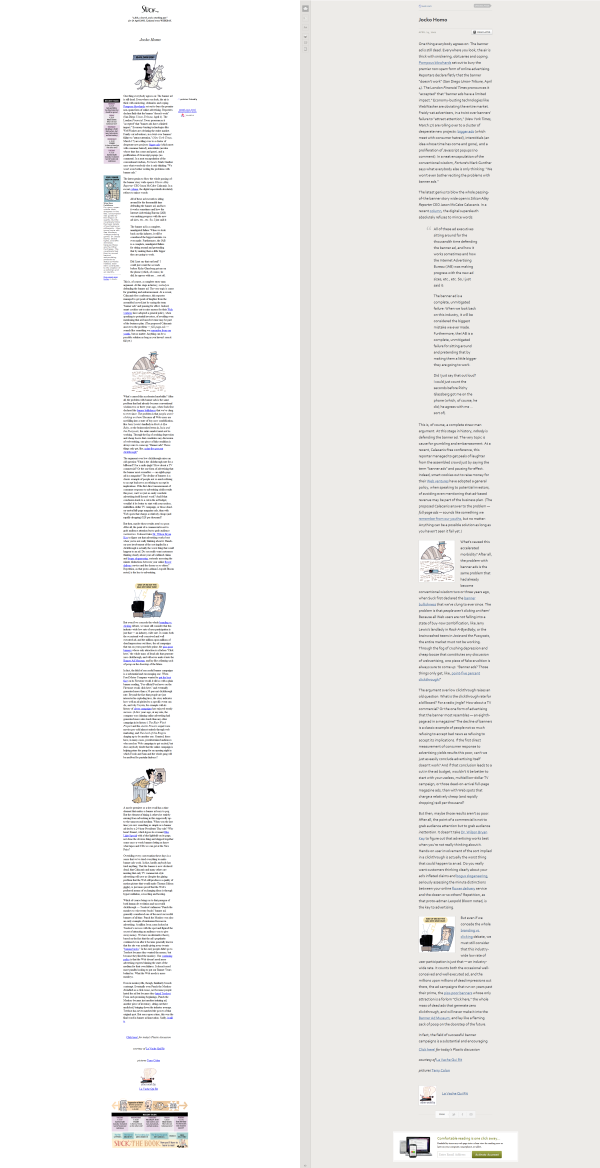26 April 2012

On the left is one of my favourite websites, Suck.com, as it looked from back when I used to read it in the mid-1990s.
On the right is how I read things in 2012.
Plus ça change.
Let me know what you think on Twitter
This short manifesto covers what I hold to be self-evident about modern marketing practices, particularly related to online activity.
This piece about how people's attention flows on the web highlights the fundamental misunderstanding that causes almost all online marketing to be ineffective.
The blog that follows consists of a series of short posts that support my arguments.

On the left is one of my favourite websites, Suck.com, as it looked from back when I used to read it in the mid-1990s.
On the right is how I read things in 2012.
Plus ça change.

Searches for ‘tumblr’ to eclipse searches for ‘blog’.
Check out the current state of these queries on Google Trends.
Marketing relies on the schemas by which we frame our collective experience. There is a general lack of critical analysis to be found among those responsible for these manipulations. The consensus is to ignore the framing within which both actor and audience simultaneously participate.
As an example I’d like to look briefly at the appropriation of the trappings of a social enterprise by Hiut Denim as a means to market to a particular psychographic.
Based in Wales and set-up by the original founders of Howies, the message they lead with across their own and third-party marketing materials is their aim “to revive Cardigan’s denim industry”. The inference is that the customer isn’t simply incurring a financial cost in buying a pair of jeans, they’re making an investment in something of value to an entire community. Not only can you feel physically good in this product, you can feel emotionally good too.
The fact Hiut employ around six people is secondary to this intent of ‘putting people back to work’. The frame being relied upon taps into a much deeper set of associations and meanings than are superficially being communicated, namely the notion of employment of any sort being ‘good’, a message endlessly repeated by the media. The marketing benefit is that Hiut are immediately perceived as a moral actor and are therefore inherently more trustworthy than another ‘brand’ whose values don’t encompass a motivation generally agreed upon to be positive.
Whether a business selling a highly priced product to a limited market can really get “400 people their jobs back making jeans” is an inherent contradiction at the heart of the proposition that’s left unaddressed.
Without the hyperbole what you’re left with is a nice product sourced from a great Japanese denim mill. What you’re in fact getting here isn’t ‘just jeans’ but ‘just marketing’ in the context of a meticulously constructed frame that encompasses a number of ideas about the entrepreneurial nature of capitalism.
If the only option you have as a resident of Cardigan after a decade is to return to a repetitive job that was previously outsourced to Morocco then that isn’t social progress. Let’s not kid ourselves that just because of the size of the business it’s a cottage industry of artisans and craftspeople. The construction of the jeans could happen anywhere, hence the original act of outsourcing that closed the old factory. There’s no actual qualitative difference except that which can be created in the mind of the prospective customer who can be convinced to pay more for the mental association being created.
Take this quote as an example:
“Our company… will keep making jeans in this town when there will always be cheaper places to make them.”
This sounds noble but is actually about creating a value differentiation as the product isn’t being sold on price. I could make jeans on the moon provided I could pass that cost onto willing customers who thought ‘moon jeans’ were worth the amount being charged. The quote reduces questions around the economics of manufacturing into a marketing message that we are not meant to analyse in any detail.
Perhaps these objections seem churlish but I have a real interest in the explicit and implicit motivations that lie behind constructs such as these. I also feel a need to question what, why and how I’m being influenced to think.
As a compare-and-contrast exercise check out Allevol and Stabo. They’re authentic and talk about what they make and don’t rely on hokie self-help aphorisms about business to sell an image. It’s telling that these people who actually directly design and make their products do not need a grandiose narrative to justify their self-schemas.
Check out these videos from Roy’s Jeans to get an idea of the industrial scale of denim manufacture at the mill and the labour it takes to put a pair together by hand.
Mother Jones started requiring registration in order to post a comment. Here’s what happened:
Your mission, should you choose to accept it, is to come up with five ways in which Facebook can increase revenue per active user. The caveat is that these ways must not alienate the user base.
That, in a nutshell, is the problem and is why the valuation is insane.